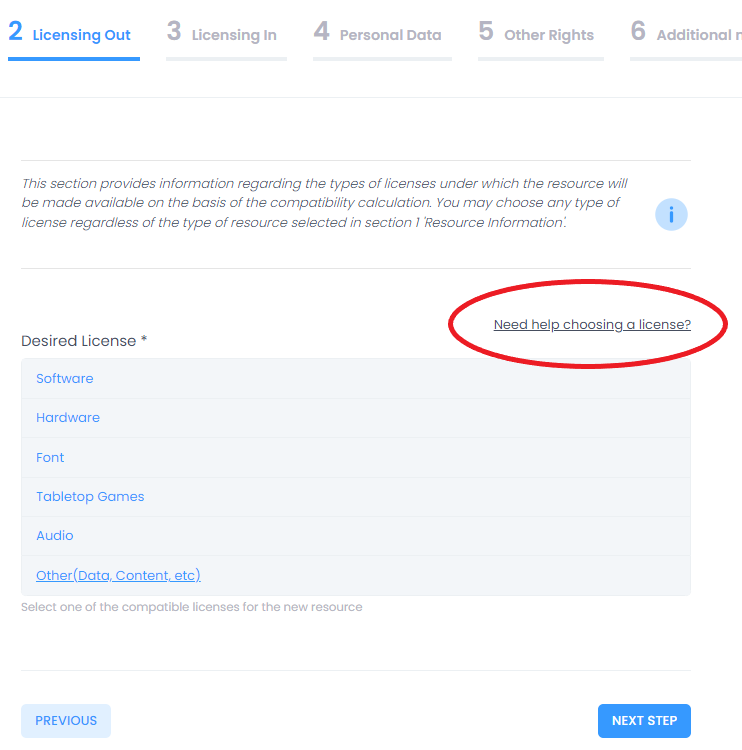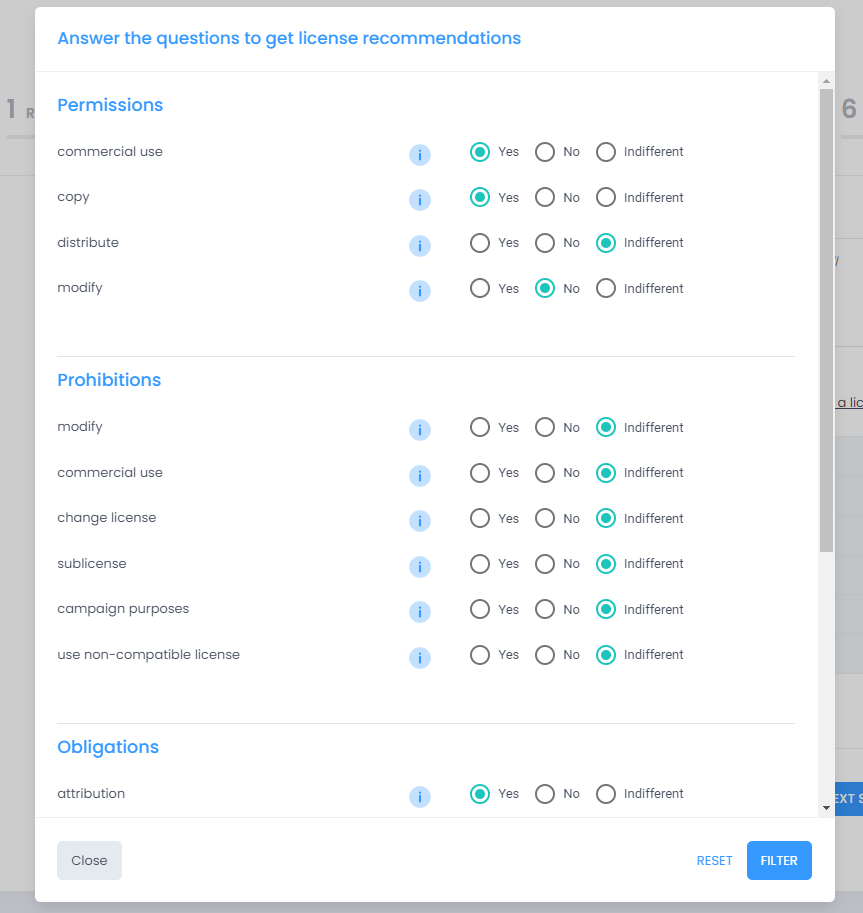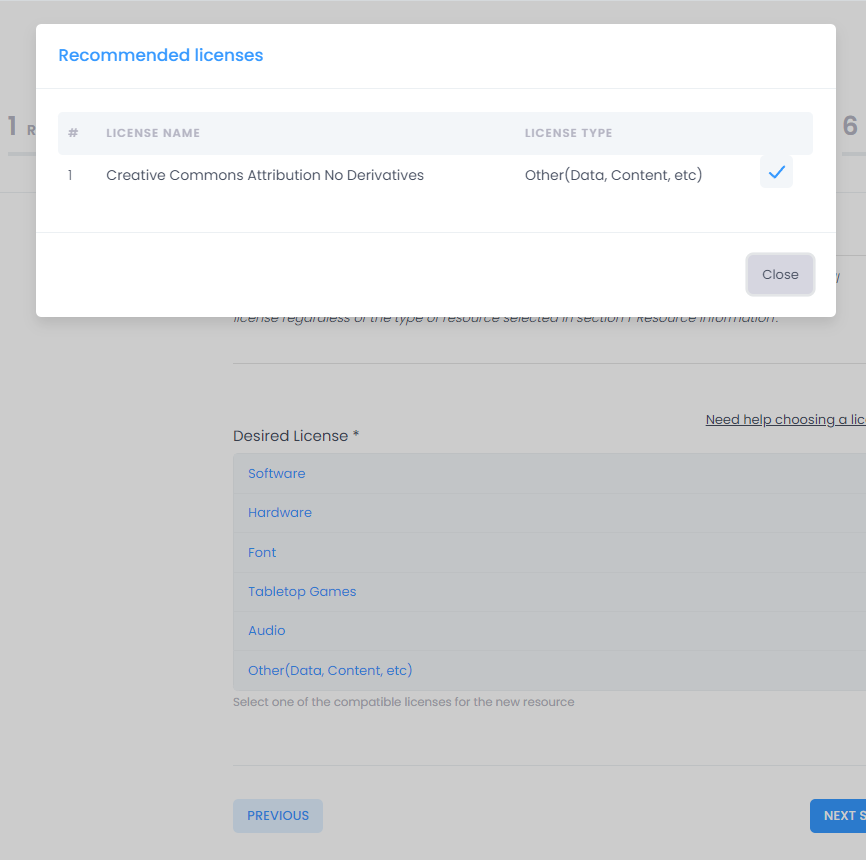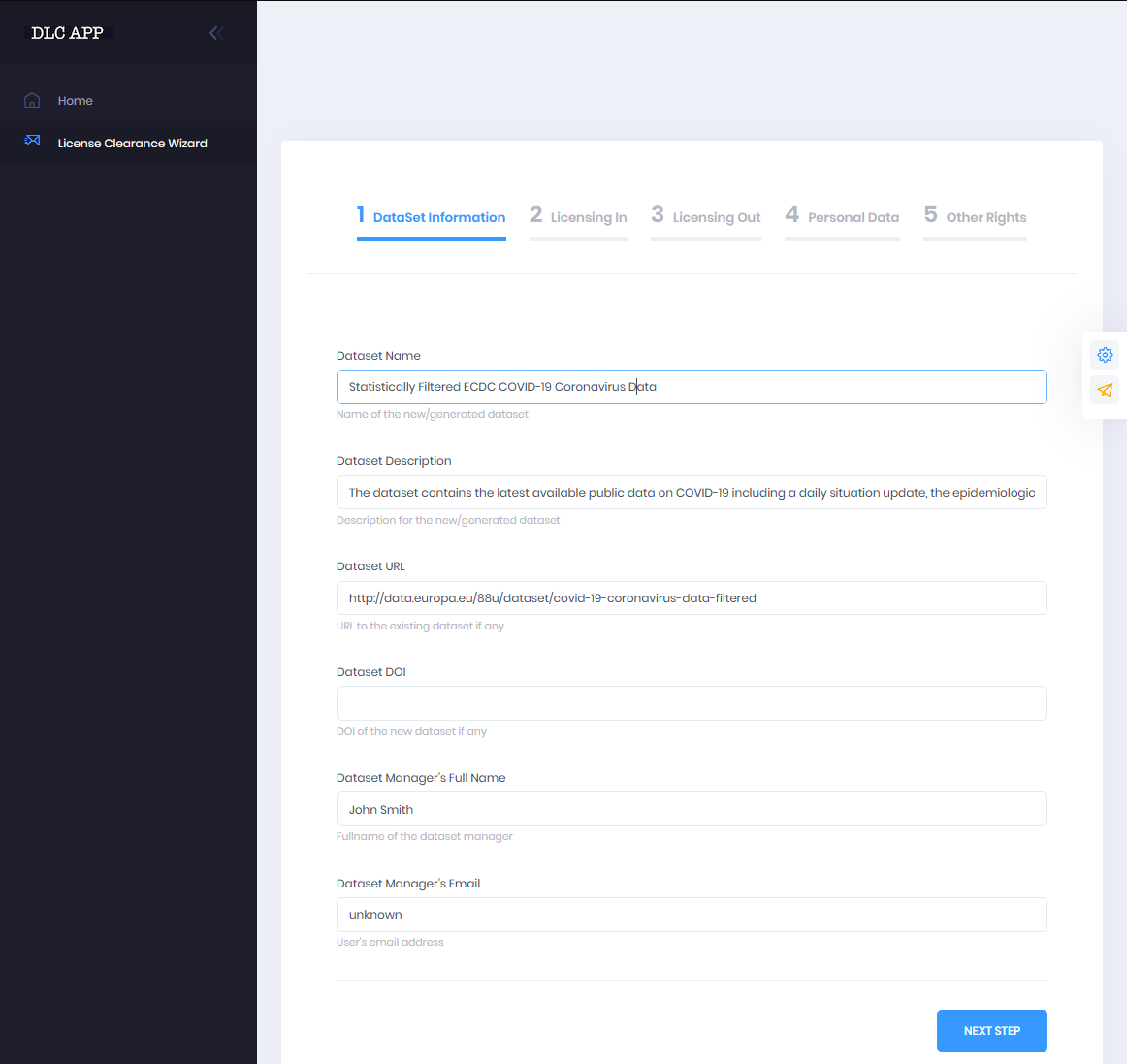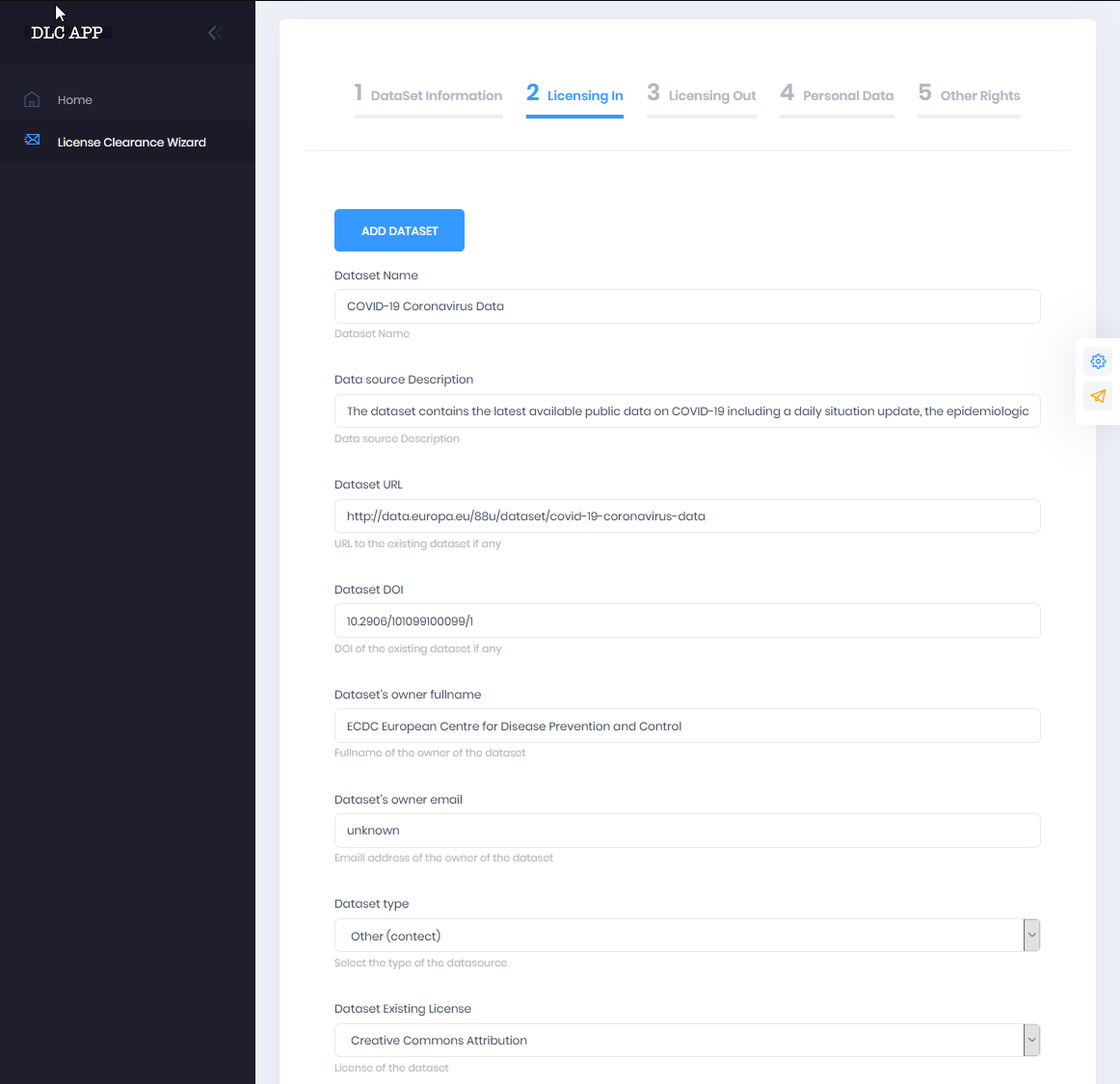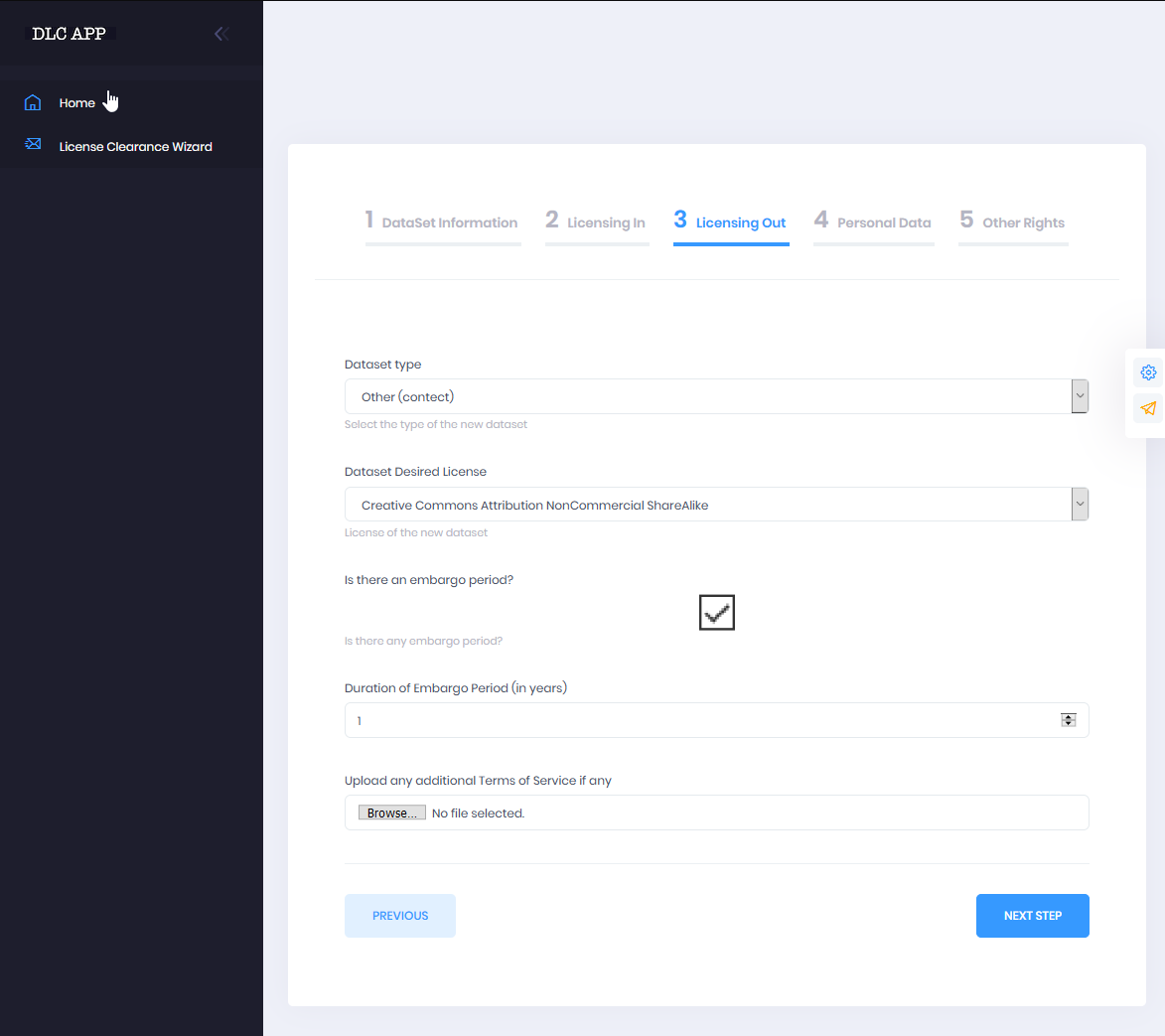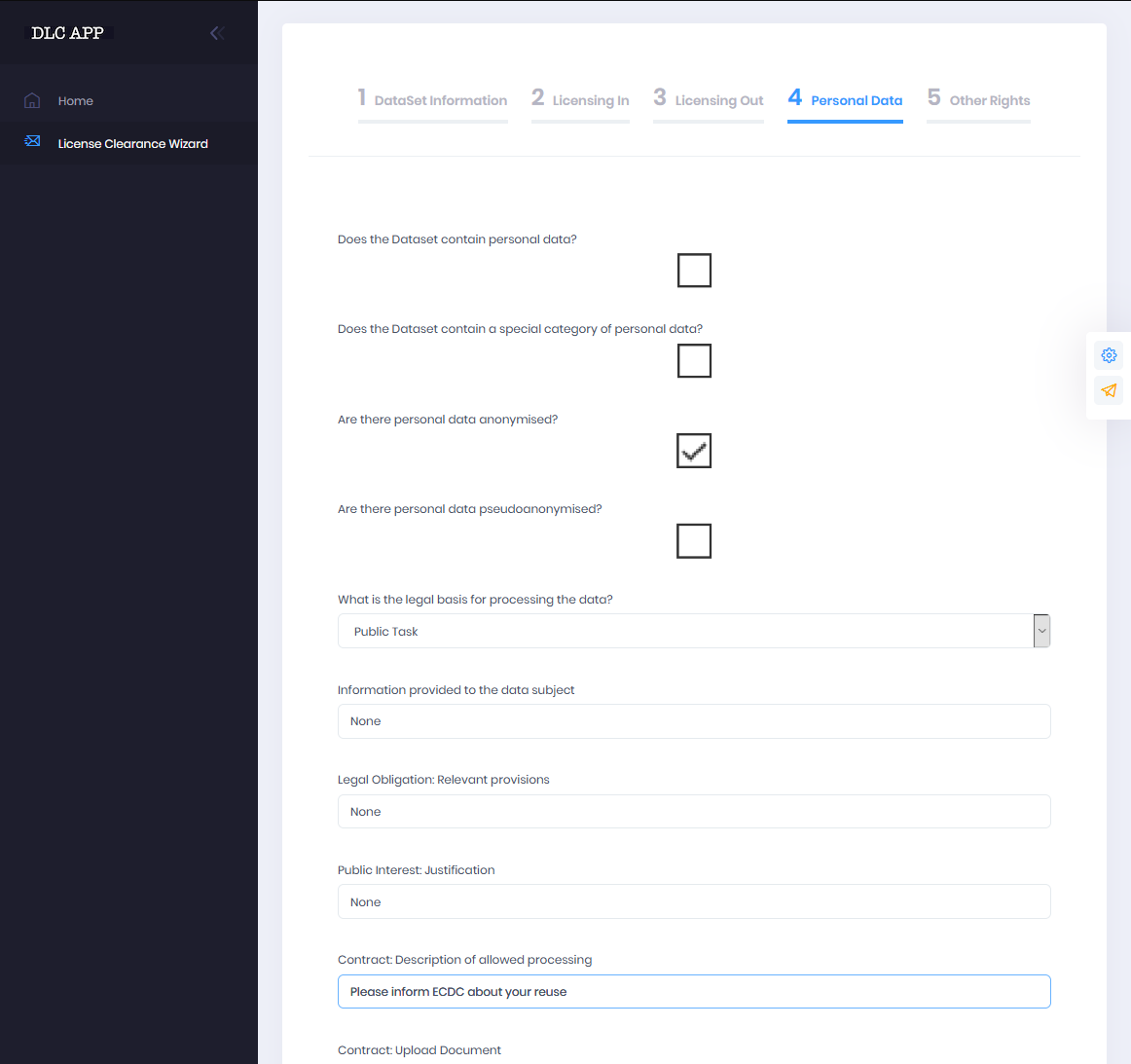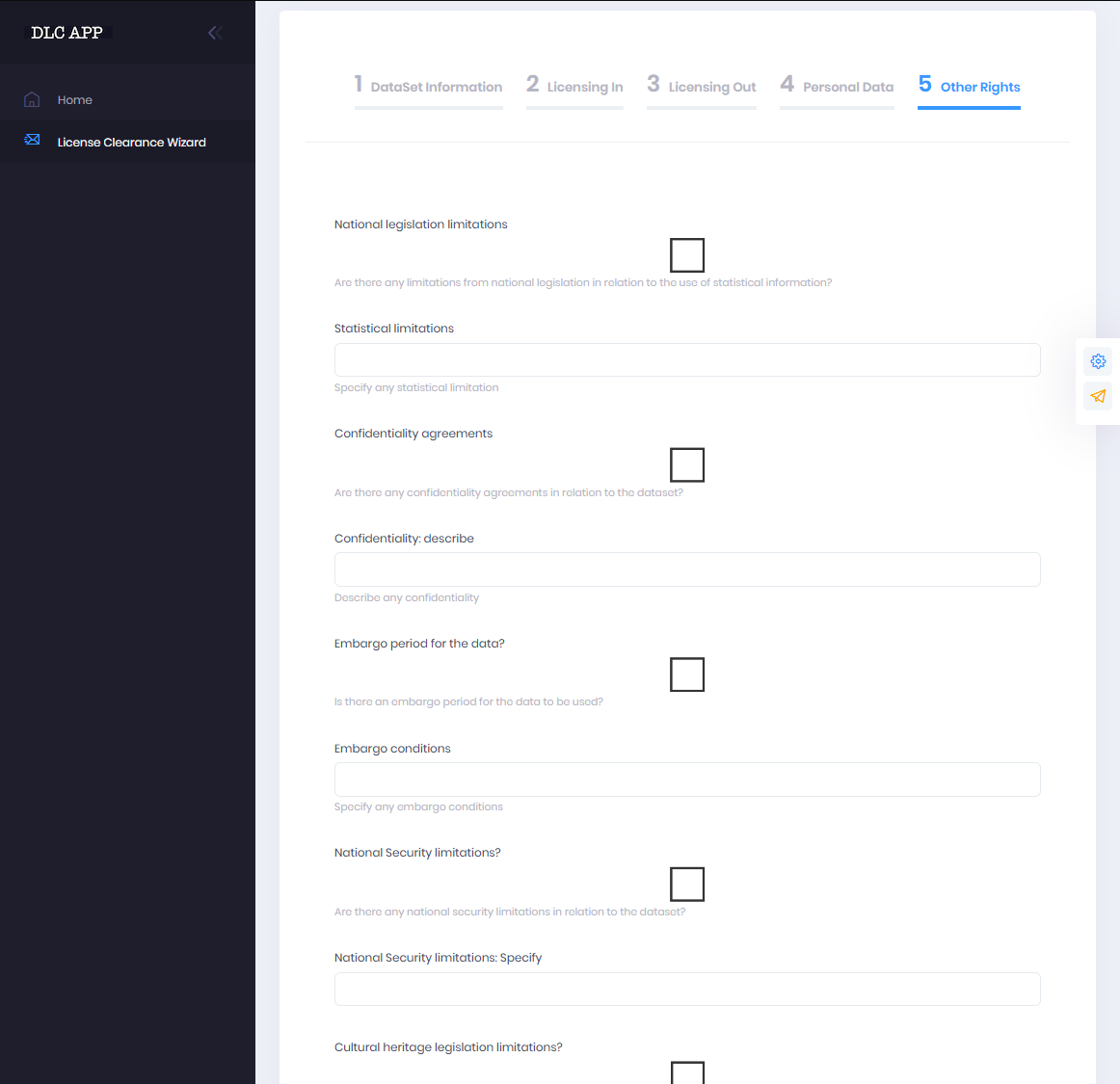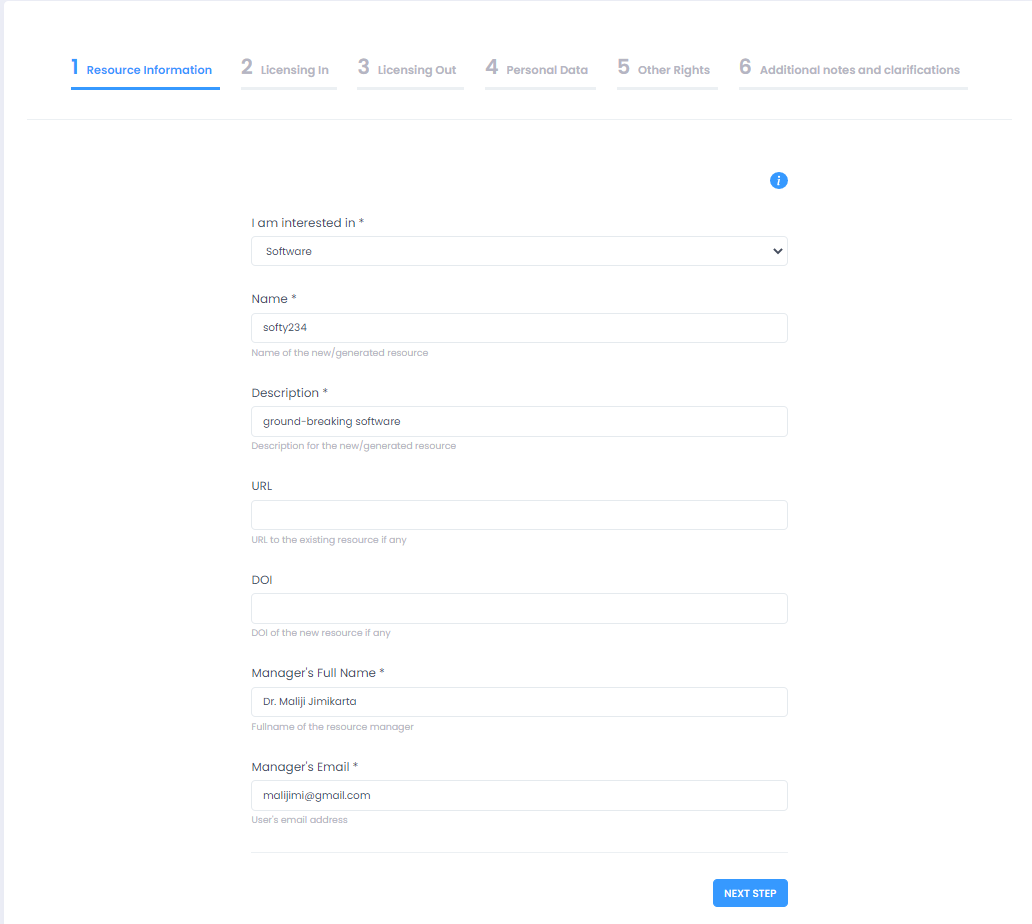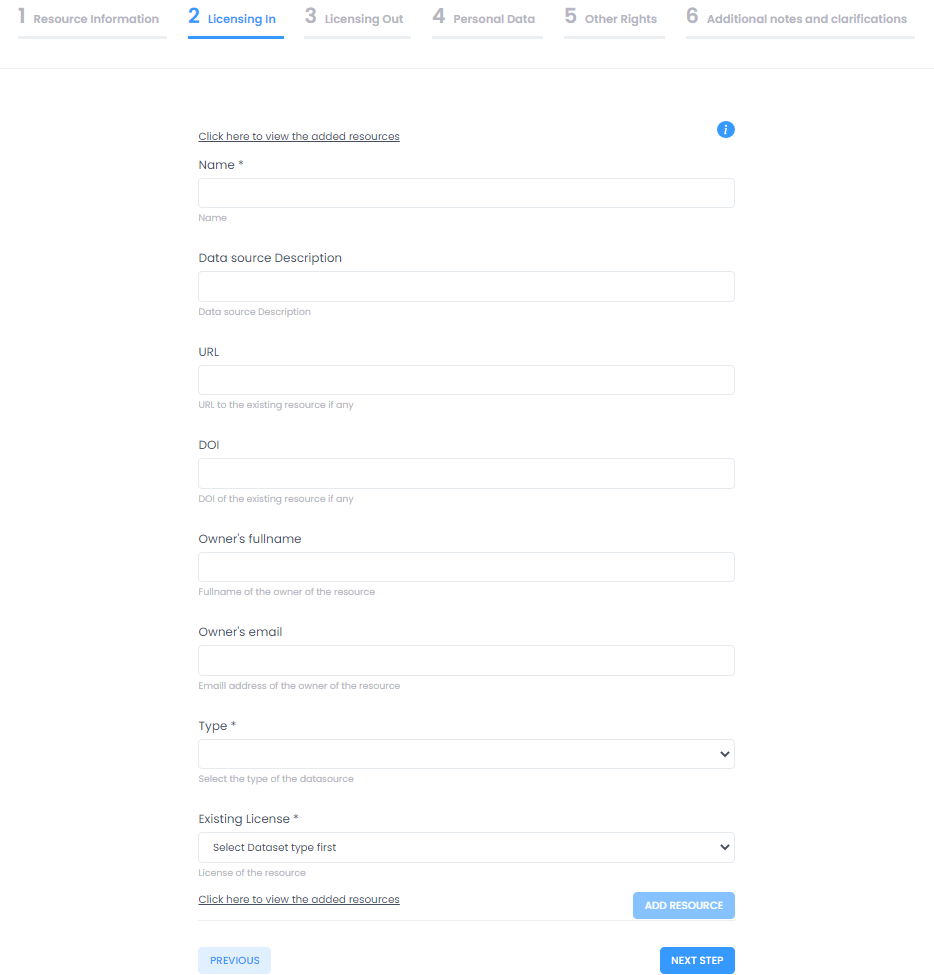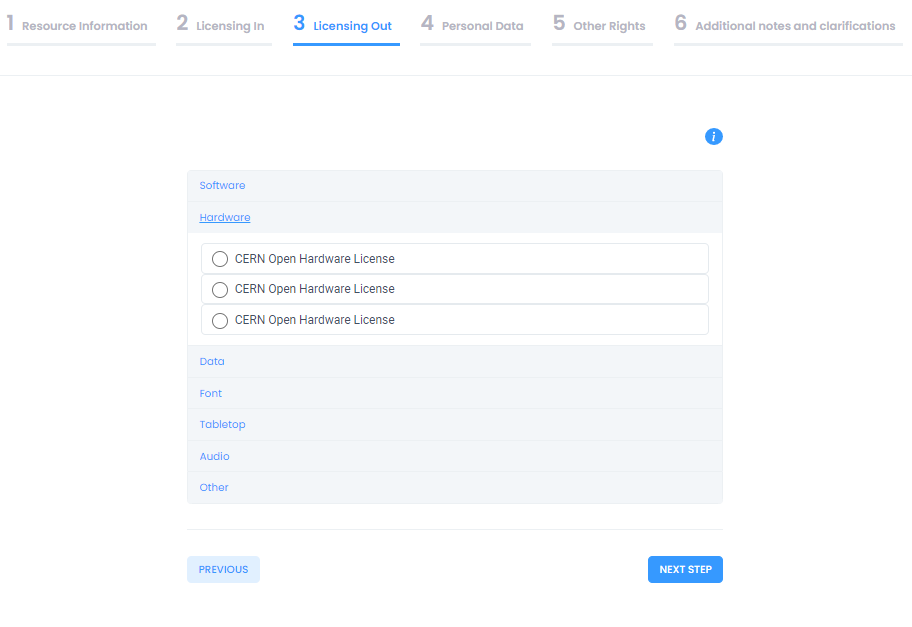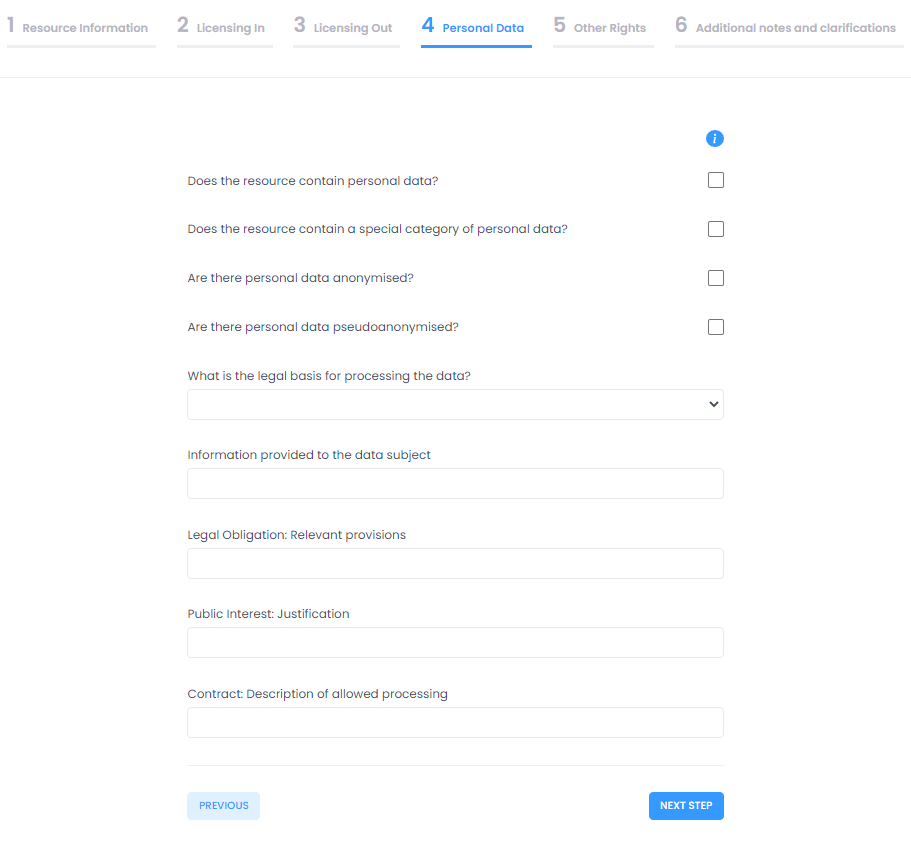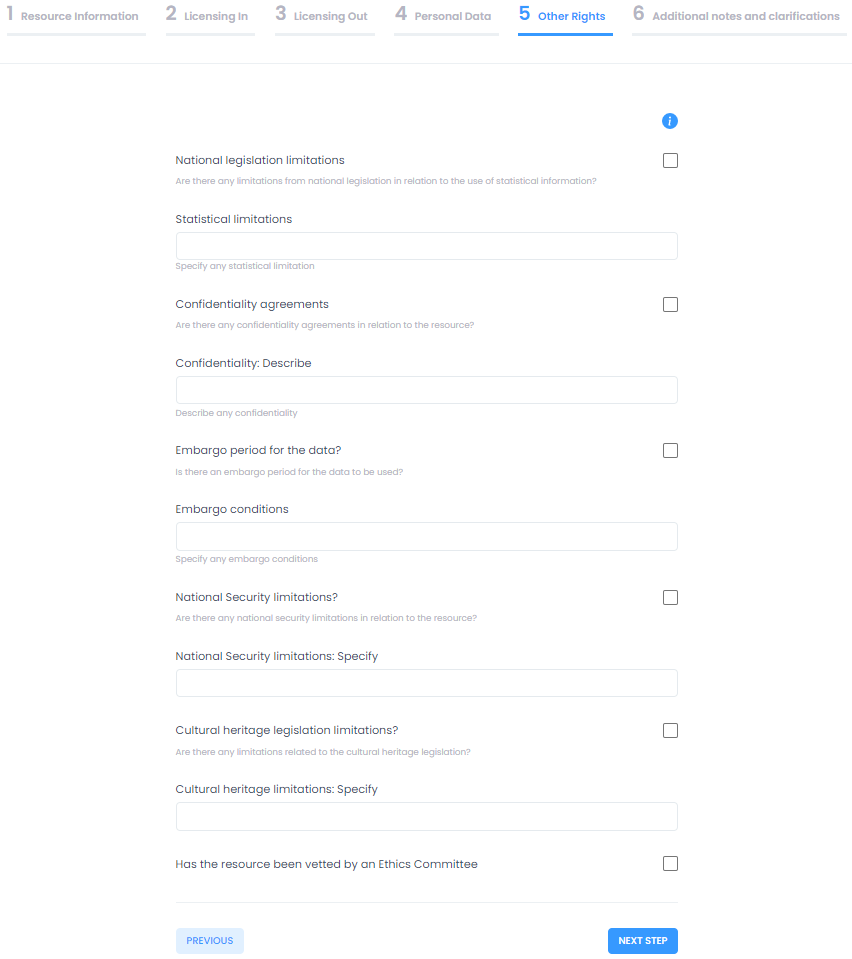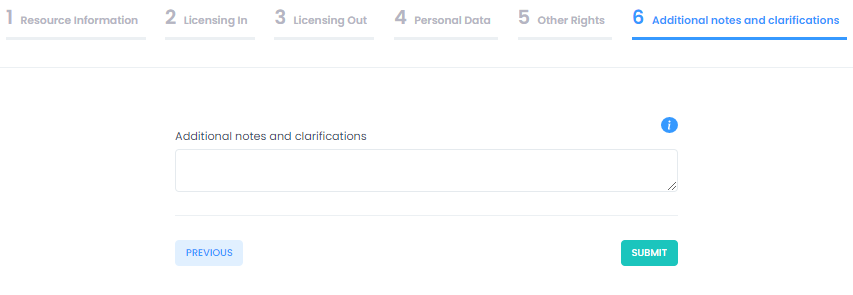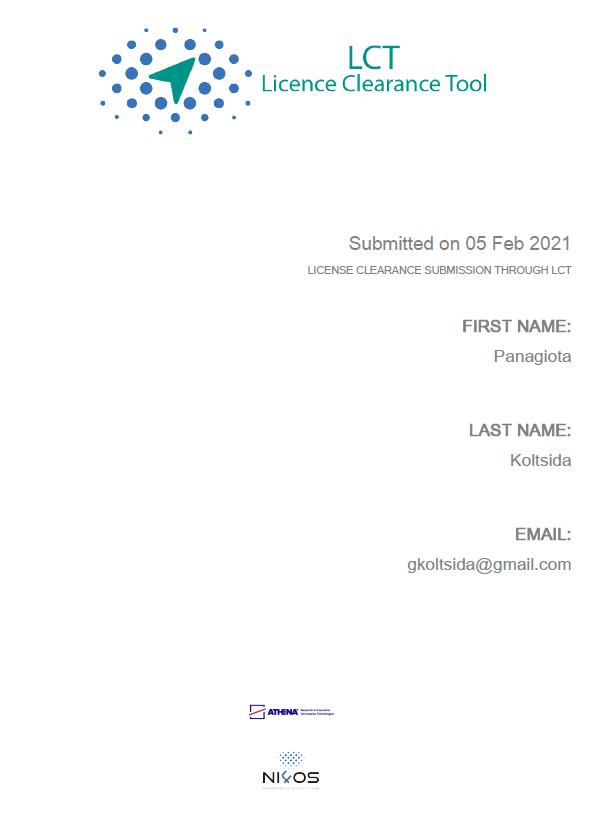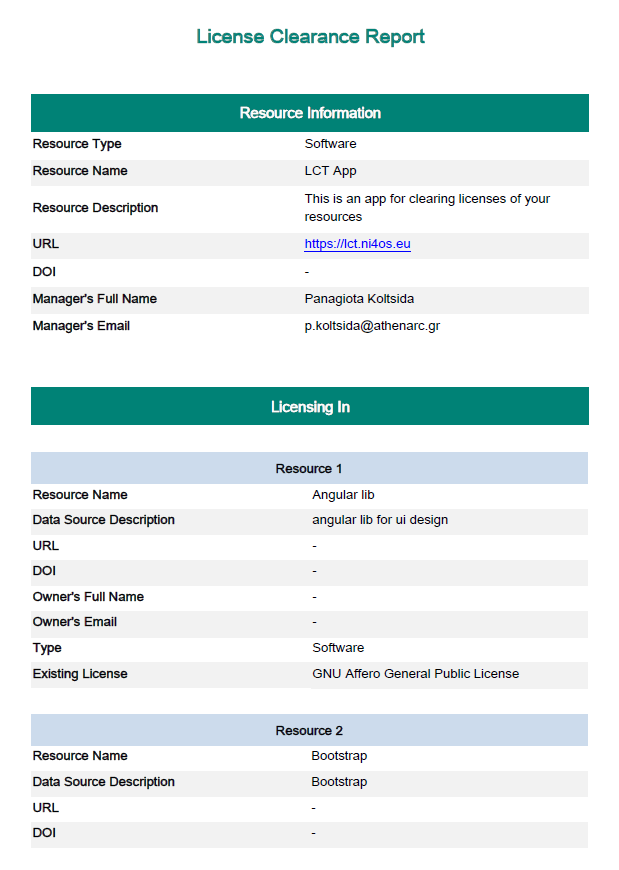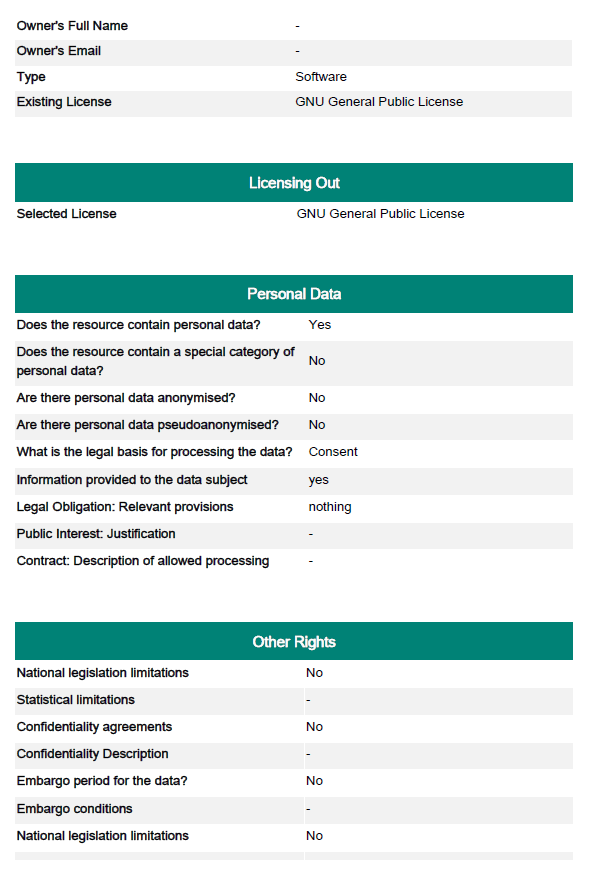Difference between revisions of "License Clearance Tool - Description and Documentation"
Eleni Toli (talk | contribs) |
Eleni Toli (talk | contribs) |
||
| (169 intermediate revisions by 3 users not shown) | |||
| Line 1: | Line 1: | ||
| − | == | + | {| class="floatright" |
| − | + | | [[File:LCT logo 813x285.png|600px|LCT logo]] | |
| + | |- | ||
| + | |- style="text-align: center; font-size: 1.5em;" | ||
| + | | '''[https://lct.ni4os.eu lct.ni4os.eu]''' | ||
| + | |} | ||
| − | + | === Purpose === | |
| − | * | + | This tool is the output for Task T4.4 that aims to mainstream concrete certification standards, tools and mechanisms for open research data management and certification schemes for data repositories, aligning with activities and results of INFRAEOSC-5c. It targets both data-intensive RDM (through cloud compute) and the curation and handling of the long tail of science with the aim of establishing consolidated models of RDM activities in the target countries. Building on the work undertaken in T4.2 and T4.3, this task delivers a certification tool for supporting trustworthiness of repositories and ensuring their FAIRness in a standardised and interoperable fashion, with the objective to support the onboarding of repositories to EOSC. |
| − | * Potentially include | + | |
| + | Newly produced datasets, but mostly the creation of derivative data or media works, i.e. for purposes like content creation, service delivery or process automation, is often accompanied by legal uncertainty about usage rights and high costs in the clearance of licensing issues. NI4OS-Europe, with the "License Clearance Tool" - LCT (https://lct.ni4os.eu/), aims to facilitate and automate the clearance of rights (copyright) for datasets, media, software that are to be cleared before they are publicly released under an open licence and/or stored at a publicly trusted FAIR repository. It will additionally allow the crowdsourced documentation of the clearance process. Main aspects of the tool include: | ||
| + | |||
| + | * Clearance not bound to the user that initiated the procedure, so it can be started and finished by different users. | ||
| + | * Potentially include crowdsourced clearance. | ||
* Clearance metadata will be an open-source resource. | * Clearance metadata will be an open-source resource. | ||
* Provides equivalence, similarity and compatibility between licenses if used in combination, particularly for derivative works. | * Provides equivalence, similarity and compatibility between licenses if used in combination, particularly for derivative works. | ||
| − | ==== | + | === Intended use === |
| + | |||
| + | The intended use of the tool is to provide a guided approach for establishing the proper open-source licence required for the creation of a new (or synthetic) dataset, media, software etc. or for the re-use of existing unlicensed content. The procedure takes into account many potential data (media, software) managers (users initiating or completing a clearance procedure). Potential users may be researchers and research organisations. | ||
| + | |||
| + | === Background: Legal aspects === | ||
| + | The License Clearance Tool (LCT) comes as a response to the increased demand for providing technical solutions to address legal aspects in FAIR and ORDM. It is, thus, intended to support researchers to publish in FAIR/open modes. As such, the tool development has been preceded by extended legal search and analysis of most used licensing schemes. These have been put in a matrix, so as to allow the comparison "all with all" and unveil compatible and conflicting licenses. | ||
| + | The first version of the tool provides guidance for existing standard open-source licenses only. The matrix, however, is continuously expanded and also includes custom licenses. The comparison of "standard to custom" and "custom to custom" poses a challenge for both: the analysis of the compatibility of licenses, but also the technical deployment of the solution. For this reason, the results of this activity are not included in the "proof of concept" version of the tool but will be implemented in the following ones. | ||
| + | |||
| + | === Service Workflows === | ||
| + | <!-- | ||
| + | TODO!!! | ||
| + | - Users should be allowed to go back, and perhaps even forth by clicking on step 1-5 titles. | ||
| + | - There is no way to remove a dataset after ADD DATASET in step 2 | ||
| + | ???? --><!-- This section describes the workflow of the service not the front-end procedure --> | ||
| + | |||
| + | Two main workflows are foreseen. These are following the two possible usage scenarios the application covers and considered to be the most needed. | ||
| − | + | According to the first scenario, a user (data manager) aims to associate an appropriate open-source licence for existing content composed by different elements that are licensed separately or for derivative work by combining licenses from the originating licensed content and possibly non-licensed content. The associated workflow, <span id="workflowI">'''Workflow I'''</span> in the flowchart below, describes the procedure designed in the tool to answer the first usage scenario. The steps followed are: | |
| + | # Start a new Rights Clearance Procedure. A user must initiate a new process for a specific content category. This process is bound to the content selected, but not the user, which means that a different user may finish the process (or alter it - forthcoming functionality). | ||
| + | # Existing dataset(s) or other content selection. These is the initial content that may be existing or future derivative work whose rights are to be cleared or require a compatible license. | ||
| + | # Identify corresponding licenses for each dataset/content. This step allows the association of each input dataset/content with a corresponding "license-in" selected from all available in a drop-down list. | ||
| + | # Compatibility processing. The tool's algorithm processes collected input to derive if an appropriate open-source license is available. | ||
| + | # Additional limitations (optional step). This step allows for introducing additional factors to the rights clearance procedure. This may allow or even require human intervention in future versions. | ||
| + | # Rights clearance report. The compatibility report for provided content and licences-in is produced, justified with appropriate links to a legal wiki (forthcoming functionality). | ||
| + | # Check incompatibility or restart the process (optional). If a compatible license option could not be found, the user may go back to review the compatible licenses of input content or re-initiate the procedure altering the given input. | ||
| + | # Final results are published. The procedure terminates and it cannot be re-initiated or altered. | ||
| − | == | + | {|style="width: 1030px; margin: 20px 25px;" |
| − | + | |+ style="caption-side:bottom;"|'''''Workflow I: From content to Rights clearance''''' | |
| + | |- | ||
| + | |[[File:workflow1.png|1024px|Workflow I]] | ||
| + | |} | ||
| − | = | + | The second usage scenario is a reverse rights clearance procedure, according to which a user (data manager) given the desired license-out verifies compatibility with existing licences-in (derivative work) or is given options for compatible licences-in for cases of existing unlicensed content. The steps followed for the associated workflow, <span id="workflowII">'''Workflow II'''</span> in the flowchart below, are: |
| − | + | # Start a new Rights Clearance Procedure. A user must initiate a new process for specific content. This process is bound to the content, but not the user, which means that a different user may finish the process (or alter it - forthcoming functionality). <!-- HOW CAN ANOTHER USER DO THAT????!!! --><!-- This describes the workflow of the service not the front-end procedure --> | |
| + | # Desired license selection. A data manager selects the license-out from a drop-down list of available open-source licenses. | ||
| + | # Identification of available compatible licenses for dataset(s)/content licenses-in. The tool's algorithm processes license-out input to derive appropriate open-source license(s). | ||
| + | # Compatibility verification with actual datasets/content. The data manager may provide the actual content to verify compatibility with proposed licenses. This step is required for a complete and verified rights clearance procedure. | ||
| + | # Additional limitations (optional step). This step allows for introducing additional factors to the rights clearance procedure. This is May allow/require human intervention in future versions. | ||
| + | # Rights clearance report. The compatibility report for provided content and licences-in is produced, justified with appropriate links to the legal wiki (forthcoming functionality). | ||
| + | # Check incompatibility or restart the process (optional). If no compatible license option could be found the user may go back to review the compatible licenses or re-initiate the procedure an alter the provided input. | ||
| + | # Final results are published. The procedure terminates and it cannot be re-initiated or altered. | ||
| − | ''Workflow | + | {|style="width:1030px; margin: 20px 25px;" |
| + | |+ style="caption-side:bottom;"|'''''Workflow II: From desired licence to content''''' | ||
| + | |- | ||
| + | |[[File:workflow2.png|1024px|Workflow II]] | ||
| + | |} | ||
| + | === License attributes filtering <span style="color:#ff0000">(Dec. 2021 update)</span> === | ||
| + | To upgrade and further extend LCT’s OS license recommendation abilities, a license characterization mechanism based on selected attributes has been established. This feature provides a means of characterizing licenses with specific key-attributes and thus allowing comparisons and filtering among the licenses on the grounds of these attributes. In turn, this enables the addition of a set of descriptive questions in the application’s frontend to ease the license selection process and further assist users in choosing appropriate licenses according to their needs. This filtering is available at the application workflows at the license choice step, where users are presented with all possible license choices according to the derivate (or original) work described. Reaching this point, users can choose to use the assistance option and respond to a set of questions corresponding to attribute-flags that will propose to them a possibly narrower list of licenses based in his / her responses. To additionally assist users making a better/easier choice, a link is provided next to each license opening a page with a summary of the license’s characteristics as it occurs by its describing attributes. | ||
| − | + | <gallery mode="packed" widths=450px heights=350px caption="LCT license attributes filtering feature"> | |
| + | Image:lct_license_choosing01.png|''Help with choosing a license''|alt=Help with choosing a license | ||
| + | Image:lct_license_choosing02.png|''Filtering questions''|alt=Filtering questions | ||
| + | Image:lct_license_choosing03.png|''Filtered recommendation''|alt=Filtered recommendation | ||
| + | </gallery> | ||
| + | ''Work has been done in two directions:'' | ||
| + | At the '''legal''' level, the team of experts screened all OS related licenses available in LCT, summarized and compiled their content per attributes. The major attributes chosen to group licenses relate to permissions, prohibitions and obligations set forth in each one including inter alia the following: waiving copyrights, allowing commercial use, allowing modifications, requiring attribution, requiring attached copyright notice etc. | ||
| − | '' | + | At the '''technical''' development level, the available licenses together with their attributes have been modelled, using the JSON notation. User input at each question level is used to create flags for each attribute, allowing to filter down suggested licenses. Users may choose to stick to the initial compatibility list created to select a desired license, or they can proceed to additional filtering of licenses, based on the provided attributes. |
| + | === Overall Architecture === | ||
| − | [[File: | + | {|style="width:535px; float:right; margin-left: 10px; margin-top: 20px" |
| + | |+ style="caption-side:bottom;"|''License clearance block-diagram'' | ||
| + | |- | ||
| + | |[[File:Ni4os-license-clearance-block-diagram_cropped.png|upright=1.0|License clearance block-diagram]] | ||
| + | |} | ||
| − | + | The License Clearance Application at its core contains a schema description that corresponds to the data that need to be filled in for processing by the clearance application. This description constitutes of a number of sections and questions, capturing all the needed information about the newly generated dataset and the existing exploited datasets (from which the new one is derived), including descriptive metadata and the available/desired licenses. It also defines the ordering of the sections and questions, any dependencies among them and the vocabularies used to fill in possible answers. | |
| − | The | + | This description will evolve with time and will be enhanced with additional data points. Aiming at being flexible, we map all the questions, the sections they belong to and the possible list of responses (if any) into a JSON (https://www.json.org/json-en.html) document stored in a NoSQL database MongoDB (https://www.mongodb.com/). |
| − | This description will evolve | ||
This schema is retrieved by the front-end application, which dynamically creates a form-based wizard. | This schema is retrieved by the front-end application, which dynamically creates a form-based wizard. | ||
==== Components==== | ==== Components==== | ||
| − | The application is composed | + | The application is composed of two main services, the back-end service and the front-end application. The back-end service is responsible for implementing all the business logic of the application and providing all the necessary methods to the front-end one, for interacting with it and making available to the end-users the User Interface for clearing the license of a new content. |
| − | The back-end service is composed | + | The back-end service is composed of a number of different components, each one of them responsible for a different part of the system. Currently, these are: |
* a user’s management component for managing the available users and their roles, | * a user’s management component for managing the available users and their roles, | ||
| Line 51: | Line 108: | ||
Data are stored either on a NoSQL database or to a relational one. | Data are stored either on a NoSQL database or to a relational one. | ||
| − | The image | + | The image besides presents the block diagram of the application. Some components have not been yet implemented but will be available during the next versions of it. |
| − | + | ====Schema Description==== | |
| − | |||
The structure of the schema description is presented below, using an example. Each section is described in a separate section. | The structure of the schema description is presented below, using an example. Each section is described in a separate section. | ||
| − | |||
''Section Description'' | ''Section Description'' | ||
| Line 68: | Line 123: | ||
The fields above describe a section. Each section contains: | The fields above describe a section. Each section contains: | ||
| − | * | + | * id: The id of the section. For internal use only |
| − | * | + | * name: A name to be displayed to the end-user |
| − | * | + | * description: A description to be displayed to the end-user |
| − | * | + | * order: The order of this section, compared to the other sections |
| − | * | + | * mandatory: If the section is mandatory or not |
| − | + | * acceptsMultiple: A field that indicates if the user could add multiple answers in this section. | |
''Question Description'' | ''Question Description'' | ||
| Line 88: | Line 143: | ||
Each question contains the following fields: | Each question contains the following fields: | ||
| − | * | + | * id: The id of the question. For internal use only |
| − | * | + | * name: The name to be displayed to the end-user |
| − | * | + | * description: The description to be displayed to the end-user |
| − | * | + | * sectionId: The section it belongs to |
| − | * | + | * order: The order of the questions in the section it belongs to |
| − | * | + | * mandatory: If the question must be answered or not |
| − | * responseType: The type of the expected response. Currently we support: ShortText, Text, Checkbox (for Boolean questions), FileUpload, * * DropDown (responses are limited to a specific list) | + | * responseType: The type of the expected response. Currently, we support: ShortText, Text, Checkbox (for Boolean questions), FileUpload, * * DropDown (responses are limited to a specific list) |
* public: If this response will be public or not | * public: If this response will be public or not | ||
* vocabularyId: valid only for responseType: DropDown. An ID to the vocabulary from which the responses will be used. | * vocabularyId: valid only for responseType: DropDown. An ID to the vocabulary from which the responses will be used. | ||
| − | * | + | * dependingQuestionId: if the responses for this question depend on the response to the previous question. <!-- HOW? MISSING IN THE EXAMPLE!!! --> |
| − | |||
''Vocabulary Description'' | ''Vocabulary Description'' | ||
| Line 119: | Line 173: | ||
] | ] | ||
| − | Each vocabulary constitutes of an Id, a name and a description and a definite number of terms. Each term has an Id and a name / label. | + | Each vocabulary constitutes of an Id, a name and a description and a definite number of terms. Each term has an Id and a name/label. |
| + | |||
| + | ==== Back-end service==== | ||
| − | |||
A REST web service is implemented using the Java EE and the Spring Boot framework. The service offers an API (Application Programmatic Interface) with all the required methods for serving the application’s needs. | A REST web service is implemented using the Java EE and the Spring Boot framework. The service offers an API (Application Programmatic Interface) with all the required methods for serving the application’s needs. | ||
| − | ==== Front-end | + | ==== Front-end application ==== |
| − | The front-end application is implemented using Angular (https://angular.io/), a TypeScript-based open-source web application framework. In its first version it offers a draft version of the | + | |
| + | The front-end application (https://lct.ni4os.eu/) is implemented using Angular (https://angular.io/), a TypeScript-based open-source web application framework. In its first version, it offers a draft version of the license clearance form wizard. The wizard is created at runtime, supporting the dynamic schema description presented above. | ||
| + | |||
| + | The actual content of the wizard may vary depending on the configuration of the questions and the licensed validator, but the following screenshots, along with ''Workflow'', illustrate the usage of LCT. | ||
| + | |||
| + | <gallery> | ||
| + | File:DLCT_1.png|1 Dataset Information | ||
| + | File:DLCT_2.png|2 Licensing In | ||
| + | File:DLCT_3.png|3 Licensing Out | ||
| + | File:DLCT_4.png|4 Personal Data | ||
| + | File:DLCT_5.png|5 Other Rights | ||
| + | </gallery> | ||
| + | |||
| + | === Usage === | ||
| + | |||
| + | {|style="width:600px; float:right; margin-left: 10px; margin-top: 10px" | ||
| + | |+ style="caption-side:bottom;"|''LCT landing page'' | ||
| + | |- | ||
| + | |[[File:Lct_landing.png|border|600px|LCT landing page]] | ||
| + | |} | ||
| + | |||
| + | The application front-end provides a straight forward procedure in six steps presented as simple forms. Users have to select values from drop-down menus, enter required input in text fields, tick check-boxes or choose content to upload. Each input field should be filled top to bottom and the required input is described before the input field. Furthermore, there is an info-button present in each section (tabs 1-6) explaining what should be entered in each field. For further queries users may use the orange shortcut button "contact us" on the right side of the screen, which will allow them to quickly access the contact form to ask their questions. All fields marked with an asterisk at the end of their description are mandatory. If input is not provided for the mandatory fields the user is not allowed to proceed to next step of the process. | ||
| + | |||
| + | '''[[:File:Lct_landing.png|LCT landing page]]''' is where the user lands after visiting the tool's url at '''[https://lct.ni4os.eu/ lct.ni4os.eu]'''. User is given the option to continue as an authenticated user or to explore the tool as a guest. As a guest the user may experience the tool's full functionality, however no information and no part of the procedure is stored after the procedure completes. All provided information will be discarded after the final report is produced. As an authenticated user all parts of the procedure are kept in the user's history and the contents' under licensing clearance history. Login is enabled with version 3 (February 2021) and registered users may access and edit their profile pages and personal reporting history. | ||
| + | |||
| + | Next screen, '''[[:File:lct_flow_choice.png|Home]]''' of the wizard is where the user chooses the desired flow from the two available work flows explained in the [[#Service_Workflows|Workflows]]. If the user chooses "I have a resource and want to clear derivate work licenses" will actually go through [[#workflowI|Workflow I]] and by choosing "I have a target license and want to understand license compatibility for initial resources" will follow [[#workflowII|Workflow II]]. The choice is made at the home screen where the users may return anytime by hitting the "home" link at the top left. At the moment users may follow the first choice representing Workflow I. | ||
| + | |||
| + | {|style="width: 1024px; margin: 20px 0px;" | ||
| + | |+ style="caption-side:bottom;"|''LCT Home screen - workflow choice'' | ||
| + | |- | ||
| + | |[[File:lct_flow_choice.png|1024px|LCT flow choice]] | ||
| + | |} | ||
| + | |||
| + | Depending on the choice, users are taken on either of the actual guided procedures for license clearance. The wizard for Workflow I starts by gathering information related to the resource to be cleared, '''Resource Information'''. Mandatory information to be provided is the resource type (data, software, audio, etc.), the name of the new/generated resource, a description for the new/generated resource, the full name of the resource manager and its email address. Next the wizard continues to the '''Licensing In''' area. This section provides information regarding the licenses under which are the different elements (subsets) of the resource and can accept any number of resources. The user may add as many resources as required here completing the fields name, type of the resource and its existing license and clicking on ''add resource'' to add each new resource. | ||
| + | |||
| + | <gallery mode="slideshow" widths=600px> | ||
| + | File:ni4os_lct_flow1_01.png|''Resource Information'' | ||
| + | File:ni4os_lct_flow1_02.png|''Licensing In'' | ||
| + | File:ni4os_lct_flow1_05.png|''Licensing Out'' | ||
| + | File:ni4os_lct_flow1_06.png|''Personal Data'' | ||
| + | File:ni4os_lct_flow1_07.png|''Other Rights'' | ||
| + | File:ni4os_lct_flow1_08.png|''Additional notes and clarifications'' | ||
| + | </gallery> | ||
| + | |||
| + | Users may see a complete list of their added resources by clicking at the link ''"Click here to view the added resources"'' and make changes by deleting a resource from the table. When all desired resources have been added, clicking ''"Next"'' will take users to the next step '''Licensing Out'''. | ||
| + | {|style="margin: 20px auto;" | ||
| + | |+ style="caption-side:bottom;"|''Licensing in - Added resources summary'' | ||
| + | |- | ||
| + | |[[File:ni4os_lct_flow1_03.png|LCT flow choice]] | ||
| + | |} | ||
| + | |||
| + | The Licensing out section provides information regarding the types of licenses under which the resource will be made available on the basis of the compatibility calculation. Compatible licenses are presented in categories according to types (software, data, audio, etc.). Users have to make a licensing out choice to move to the next section. Sections 4 and 5 gather further information regarding the legal bases under which the resource may be lawfully processed and provide a check-list of other types of rights that should be cleared before the resource is released to further assist resource managers in the clearance procedure. The last section provides a means to gather other notes and clarifications regarding rights and permissions related to the resource and enable future human interaction particularly concerning specialized legal advice. At this point users may hit ''"Submit"'' to trigger the creation of the output report, which may be downloaded once it has been generated by the platform. A sample report may be seen below: | ||
| + | |||
| + | <gallery mode="slideshow" widths=600px> | ||
| + | File:Lct_report_01_16022021.png|''LCT report page 1'' | ||
| + | File:Lct_report_02_16022021.png|''LCT report page 2'' | ||
| + | File:Lct_report_03_16022021.png|''LCT report page 3'' | ||
| + | </gallery> | ||
| + | |||
| + | A user profile page is available for logged in users, showing the information received by the NI4OS-Europe AAI service. Users have the ability to edit/add non-essential information in their profile page, which is information that is not associated with the AAI mechanism. Clearances history is also available for logged in users, providing a list with previous wizard runs along with the produced reports. Users may download previous reports or access the wizard with the previously saved data and make modifications. | ||
| + | |||
| + | {|style="margin: 20px auto;" | ||
| + | |+ style="caption-side:bottom;"|''User profile and User clearances history pages'' | ||
| + | |- | ||
| + | |[[File:Lct_profile_page_01_16022021.png|600px|LCT user profile page]] [[File:Lct_clearances_history_01_16022021.png|600px|LCT user clearances history]] | ||
| + | |} | ||
| + | |||
| + | |||
| + | === Video Tutorial === | ||
| + | [[File:Lct demo.mp4]] | ||
| + | |||
| + | === Disclaimer=== | ||
| + | |||
| + | LCT and the produced reports do not constitute legal advice and should not be construed as such. If you need legal advice in relation to the release of your resources, please seek advice from a qualified lawyer in your jurisdiction. Athena Research Center and NI4OS-Europe project is not liable for any information, data or other input added to the application services by the users. | ||
=== Version features=== | === Version features=== | ||
| + | |||
| + | '''''Version 1, June 2020:''''' | ||
| + | |||
* Initial version provides a proof-of-concept workflow. | * Initial version provides a proof-of-concept workflow. | ||
* Will initially provide guidance for existing standard open-source licenses only. | * Will initially provide guidance for existing standard open-source licenses only. | ||
| + | * General Privacy policy is formulated | ||
| + | |||
| + | '''''Release 1.0, September 2020:''''' | ||
| + | |||
| + | * Name change to match the wider purpose of the tool. | ||
| + | * Production server reached at https://lct.ni4os.eu/ | ||
| + | * Contact/issues form. | ||
| + | * Documentation, questions shortcut buttons. | ||
| + | * New branding logo. | ||
| + | * Updated Privacy Policy. | ||
| + | * Added terms of use. | ||
| + | * Reworked back-end compatibility algorithm. | ||
| + | * Reworked user interface. | ||
| + | * Added ability to input free text notes (Tab 6). | ||
| + | * Mandatory fields validation. | ||
| + | * Create e-mail service | ||
| + | |||
| + | '''''Release 1.1, February 2021:''''' | ||
| + | |||
| + | * Added AAI mechanism utilising NI4OS-Europe AAI | ||
| + | * Added registered users profile pages | ||
| + | * User profile page may be edited. | ||
| + | * Reporting history for each registered user is automatically saved. | ||
| + | * Older reports for registered users may be accessed, loaded and edited and produced reports may be re-downloaded. | ||
| + | * Cookies policy and consent has been added. | ||
| + | * Privacy policy has been updated. | ||
| + | |||
| + | '''''Release 1.2, May 2021:''''' | ||
| + | |||
| + | * Second workflow functionality added. | ||
| + | * User manual produced. | ||
| + | * Privacy policy has been updated. | ||
| + | * Terms of Use added. | ||
| + | * Renamed releases. | ||
| + | |||
| + | '''''Release 1.3, July 2021:''''' | ||
| + | |||
| + | * Admin pages added for privileged users. | ||
| + | * Tool description updated to reflect project review recommendations. | ||
| + | * Updated user manual and added easy access link within the application. | ||
| + | * Updated Privacy Policy. | ||
| + | * Updated terms of use. | ||
| + | |||
| + | '''''Release 2.0, December 2021:''''' | ||
| + | * Licenses’ attributes integration on all licenses | ||
| + | * Integration of license recommendation functionality in both workflows | ||
| + | * New page has been added in the app to provide information for each license | ||
| + | * Custom Cookie banner implementation to allow users to accept or decline the usage of analytics | ||
| + | * Integration with Google analytics | ||
| + | * Performance improvements. Faster loading of the form wizard | ||
| + | |||
| + | === Team === | ||
| + | |||
| + | Panagiota Koltsida, | ||
| + | Marianna Katrakazi, | ||
| + | Christos Liatas, | ||
| + | George Panagiotopoulos, | ||
| + | Panoraia Spiliopoulou, | ||
| + | Theodore Stefou, | ||
| + | Eleni Toli | ||
Latest revision as of 13:26, 7 February 2023

|
| lct.ni4os.eu |
Purpose
This tool is the output for Task T4.4 that aims to mainstream concrete certification standards, tools and mechanisms for open research data management and certification schemes for data repositories, aligning with activities and results of INFRAEOSC-5c. It targets both data-intensive RDM (through cloud compute) and the curation and handling of the long tail of science with the aim of establishing consolidated models of RDM activities in the target countries. Building on the work undertaken in T4.2 and T4.3, this task delivers a certification tool for supporting trustworthiness of repositories and ensuring their FAIRness in a standardised and interoperable fashion, with the objective to support the onboarding of repositories to EOSC.
Newly produced datasets, but mostly the creation of derivative data or media works, i.e. for purposes like content creation, service delivery or process automation, is often accompanied by legal uncertainty about usage rights and high costs in the clearance of licensing issues. NI4OS-Europe, with the "License Clearance Tool" - LCT (https://lct.ni4os.eu/), aims to facilitate and automate the clearance of rights (copyright) for datasets, media, software that are to be cleared before they are publicly released under an open licence and/or stored at a publicly trusted FAIR repository. It will additionally allow the crowdsourced documentation of the clearance process. Main aspects of the tool include:
- Clearance not bound to the user that initiated the procedure, so it can be started and finished by different users.
- Potentially include crowdsourced clearance.
- Clearance metadata will be an open-source resource.
- Provides equivalence, similarity and compatibility between licenses if used in combination, particularly for derivative works.
Intended use
The intended use of the tool is to provide a guided approach for establishing the proper open-source licence required for the creation of a new (or synthetic) dataset, media, software etc. or for the re-use of existing unlicensed content. The procedure takes into account many potential data (media, software) managers (users initiating or completing a clearance procedure). Potential users may be researchers and research organisations.
Background: Legal aspects
The License Clearance Tool (LCT) comes as a response to the increased demand for providing technical solutions to address legal aspects in FAIR and ORDM. It is, thus, intended to support researchers to publish in FAIR/open modes. As such, the tool development has been preceded by extended legal search and analysis of most used licensing schemes. These have been put in a matrix, so as to allow the comparison "all with all" and unveil compatible and conflicting licenses. The first version of the tool provides guidance for existing standard open-source licenses only. The matrix, however, is continuously expanded and also includes custom licenses. The comparison of "standard to custom" and "custom to custom" poses a challenge for both: the analysis of the compatibility of licenses, but also the technical deployment of the solution. For this reason, the results of this activity are not included in the "proof of concept" version of the tool but will be implemented in the following ones.
Service Workflows
Two main workflows are foreseen. These are following the two possible usage scenarios the application covers and considered to be the most needed.
According to the first scenario, a user (data manager) aims to associate an appropriate open-source licence for existing content composed by different elements that are licensed separately or for derivative work by combining licenses from the originating licensed content and possibly non-licensed content. The associated workflow, Workflow I in the flowchart below, describes the procedure designed in the tool to answer the first usage scenario. The steps followed are:
- Start a new Rights Clearance Procedure. A user must initiate a new process for a specific content category. This process is bound to the content selected, but not the user, which means that a different user may finish the process (or alter it - forthcoming functionality).
- Existing dataset(s) or other content selection. These is the initial content that may be existing or future derivative work whose rights are to be cleared or require a compatible license.
- Identify corresponding licenses for each dataset/content. This step allows the association of each input dataset/content with a corresponding "license-in" selected from all available in a drop-down list.
- Compatibility processing. The tool's algorithm processes collected input to derive if an appropriate open-source license is available.
- Additional limitations (optional step). This step allows for introducing additional factors to the rights clearance procedure. This may allow or even require human intervention in future versions.
- Rights clearance report. The compatibility report for provided content and licences-in is produced, justified with appropriate links to a legal wiki (forthcoming functionality).
- Check incompatibility or restart the process (optional). If a compatible license option could not be found, the user may go back to review the compatible licenses of input content or re-initiate the procedure altering the given input.
- Final results are published. The procedure terminates and it cannot be re-initiated or altered.
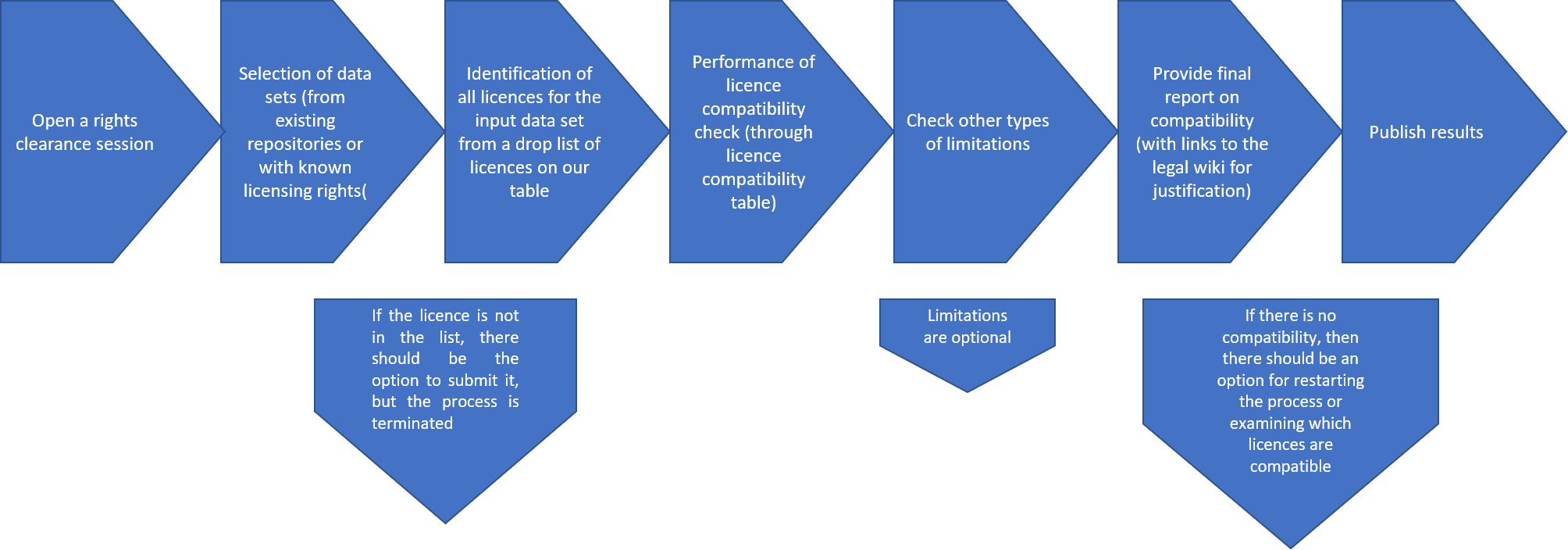
|
The second usage scenario is a reverse rights clearance procedure, according to which a user (data manager) given the desired license-out verifies compatibility with existing licences-in (derivative work) or is given options for compatible licences-in for cases of existing unlicensed content. The steps followed for the associated workflow, Workflow II in the flowchart below, are:
- Start a new Rights Clearance Procedure. A user must initiate a new process for specific content. This process is bound to the content, but not the user, which means that a different user may finish the process (or alter it - forthcoming functionality).
- Desired license selection. A data manager selects the license-out from a drop-down list of available open-source licenses.
- Identification of available compatible licenses for dataset(s)/content licenses-in. The tool's algorithm processes license-out input to derive appropriate open-source license(s).
- Compatibility verification with actual datasets/content. The data manager may provide the actual content to verify compatibility with proposed licenses. This step is required for a complete and verified rights clearance procedure.
- Additional limitations (optional step). This step allows for introducing additional factors to the rights clearance procedure. This is May allow/require human intervention in future versions.
- Rights clearance report. The compatibility report for provided content and licences-in is produced, justified with appropriate links to the legal wiki (forthcoming functionality).
- Check incompatibility or restart the process (optional). If no compatible license option could be found the user may go back to review the compatible licenses or re-initiate the procedure an alter the provided input.
- Final results are published. The procedure terminates and it cannot be re-initiated or altered.
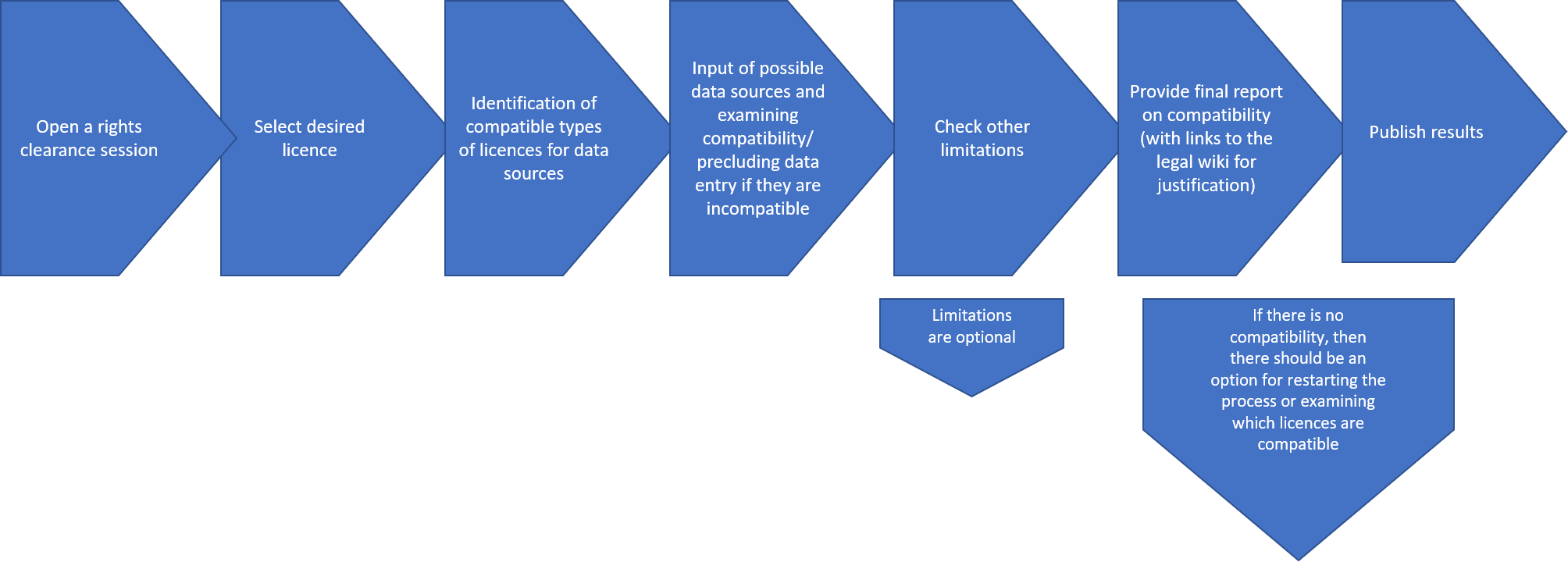
|
License attributes filtering (Dec. 2021 update)
To upgrade and further extend LCT’s OS license recommendation abilities, a license characterization mechanism based on selected attributes has been established. This feature provides a means of characterizing licenses with specific key-attributes and thus allowing comparisons and filtering among the licenses on the grounds of these attributes. In turn, this enables the addition of a set of descriptive questions in the application’s frontend to ease the license selection process and further assist users in choosing appropriate licenses according to their needs. This filtering is available at the application workflows at the license choice step, where users are presented with all possible license choices according to the derivate (or original) work described. Reaching this point, users can choose to use the assistance option and respond to a set of questions corresponding to attribute-flags that will propose to them a possibly narrower list of licenses based in his / her responses. To additionally assist users making a better/easier choice, a link is provided next to each license opening a page with a summary of the license’s characteristics as it occurs by its describing attributes.
- LCT license attributes filtering feature
Work has been done in two directions:
At the legal level, the team of experts screened all OS related licenses available in LCT, summarized and compiled their content per attributes. The major attributes chosen to group licenses relate to permissions, prohibitions and obligations set forth in each one including inter alia the following: waiving copyrights, allowing commercial use, allowing modifications, requiring attribution, requiring attached copyright notice etc.
At the technical development level, the available licenses together with their attributes have been modelled, using the JSON notation. User input at each question level is used to create flags for each attribute, allowing to filter down suggested licenses. Users may choose to stick to the initial compatibility list created to select a desired license, or they can proceed to additional filtering of licenses, based on the provided attributes.
Overall Architecture
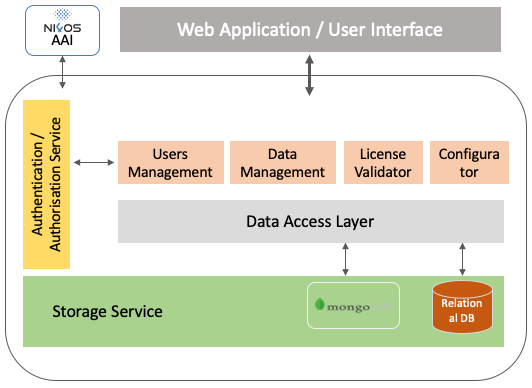
|
The License Clearance Application at its core contains a schema description that corresponds to the data that need to be filled in for processing by the clearance application. This description constitutes of a number of sections and questions, capturing all the needed information about the newly generated dataset and the existing exploited datasets (from which the new one is derived), including descriptive metadata and the available/desired licenses. It also defines the ordering of the sections and questions, any dependencies among them and the vocabularies used to fill in possible answers. This description will evolve with time and will be enhanced with additional data points. Aiming at being flexible, we map all the questions, the sections they belong to and the possible list of responses (if any) into a JSON (https://www.json.org/json-en.html) document stored in a NoSQL database MongoDB (https://www.mongodb.com/). This schema is retrieved by the front-end application, which dynamically creates a form-based wizard.
Components
The application is composed of two main services, the back-end service and the front-end application. The back-end service is responsible for implementing all the business logic of the application and providing all the necessary methods to the front-end one, for interacting with it and making available to the end-users the User Interface for clearing the license of a new content. The back-end service is composed of a number of different components, each one of them responsible for a different part of the system. Currently, these are:
- a user’s management component for managing the available users and their roles,
- the data management component for managing all the data and interacting with the data access layer,
- the configurator component for manipulating the schema description and
- the license validator component.
Data are stored either on a NoSQL database or to a relational one. The image besides presents the block diagram of the application. Some components have not been yet implemented but will be available during the next versions of it.
Schema Description
The structure of the schema description is presented below, using an example. Each section is described in a separate section.
Section Description
"id": "s01",
"name": "DataSet Information",
"description": "Information about the generated dataset",
"order": 1,
"mandatory": true,
"acceptsMultiple": false
The fields above describe a section. Each section contains:
- id: The id of the section. For internal use only
- name: A name to be displayed to the end-user
- description: A description to be displayed to the end-user
- order: The order of this section, compared to the other sections
- mandatory: If the section is mandatory or not
- acceptsMultiple: A field that indicates if the user could add multiple answers in this section.
Question Description
"id": "q013",
"name": "Dataset type",
"description": "Select the type of the datasource",
"sectionId": "s02",
"order": 7,
"mandatory": true,
"responseType": "DropDown",
"dependingQuestionId": "q011",
"public": true,
"vocabularyId": "v001"
Each question contains the following fields:
- id: The id of the question. For internal use only
- name: The name to be displayed to the end-user
- description: The description to be displayed to the end-user
- sectionId: The section it belongs to
- order: The order of the questions in the section it belongs to
- mandatory: If the question must be answered or not
- responseType: The type of the expected response. Currently, we support: ShortText, Text, Checkbox (for Boolean questions), FileUpload, * * DropDown (responses are limited to a specific list)
- public: If this response will be public or not
- vocabularyId: valid only for responseType: DropDown. An ID to the vocabulary from which the responses will be used.
- dependingQuestionId: if the responses for this question depend on the response to the previous question.
Vocabulary Description
"id":"v003",
"name":"Hardware Licenses",
"description":"Hardware Licenses",
"terms":[
{
"id":"v003_001",
"name": "CERN Open Hardware License"
},
{
"id":"v003_002",
"name": "Simputer General"
},
{
"id":"v003_003",
"name": "TAPR Open Hardware License"
}
]
Each vocabulary constitutes of an Id, a name and a description and a definite number of terms. Each term has an Id and a name/label.
Back-end service
A REST web service is implemented using the Java EE and the Spring Boot framework. The service offers an API (Application Programmatic Interface) with all the required methods for serving the application’s needs.
Front-end application
The front-end application (https://lct.ni4os.eu/) is implemented using Angular (https://angular.io/), a TypeScript-based open-source web application framework. In its first version, it offers a draft version of the license clearance form wizard. The wizard is created at runtime, supporting the dynamic schema description presented above.
The actual content of the wizard may vary depending on the configuration of the questions and the licensed validator, but the following screenshots, along with Workflow, illustrate the usage of LCT.
Usage
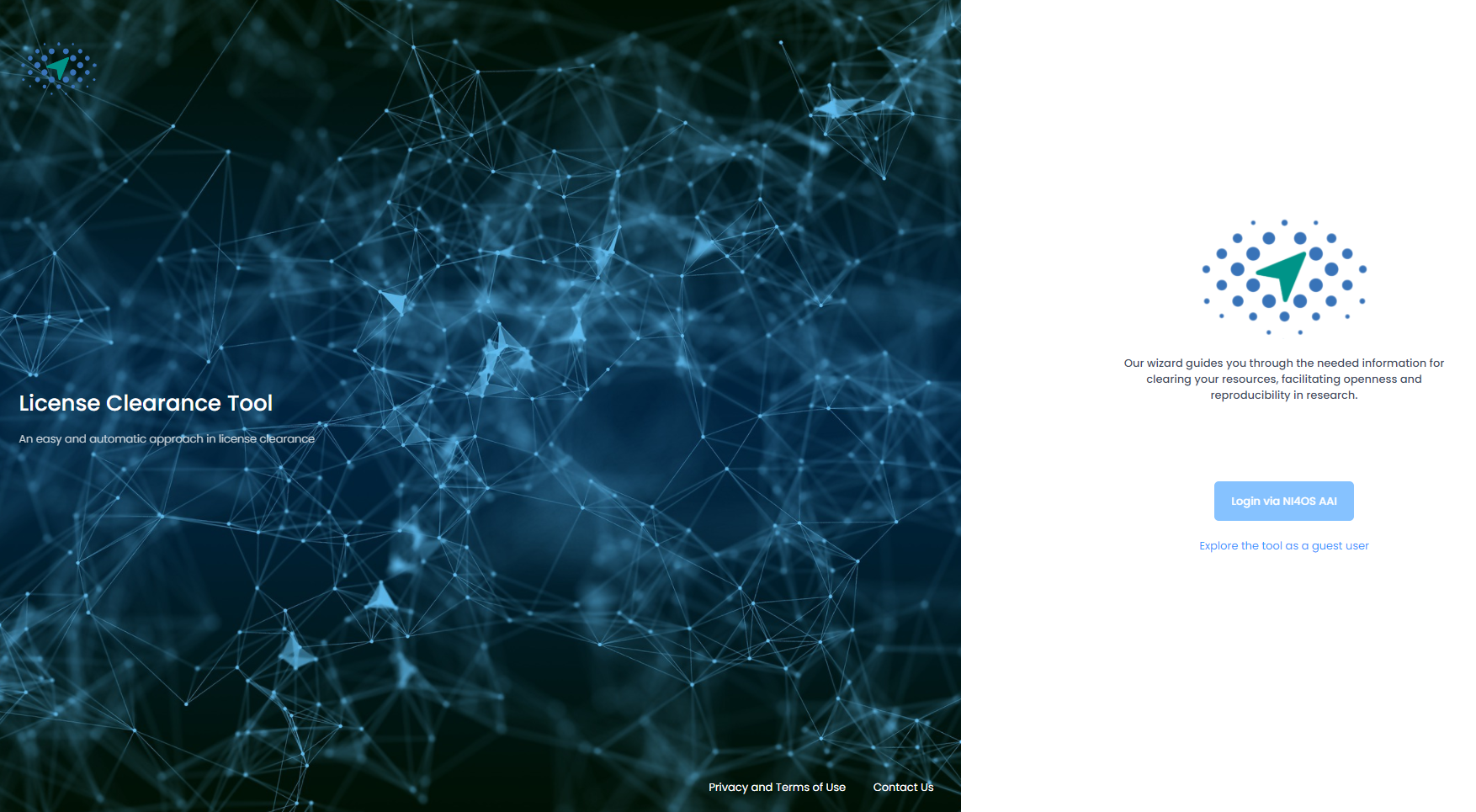
|
The application front-end provides a straight forward procedure in six steps presented as simple forms. Users have to select values from drop-down menus, enter required input in text fields, tick check-boxes or choose content to upload. Each input field should be filled top to bottom and the required input is described before the input field. Furthermore, there is an info-button present in each section (tabs 1-6) explaining what should be entered in each field. For further queries users may use the orange shortcut button "contact us" on the right side of the screen, which will allow them to quickly access the contact form to ask their questions. All fields marked with an asterisk at the end of their description are mandatory. If input is not provided for the mandatory fields the user is not allowed to proceed to next step of the process.
LCT landing page is where the user lands after visiting the tool's url at lct.ni4os.eu. User is given the option to continue as an authenticated user or to explore the tool as a guest. As a guest the user may experience the tool's full functionality, however no information and no part of the procedure is stored after the procedure completes. All provided information will be discarded after the final report is produced. As an authenticated user all parts of the procedure are kept in the user's history and the contents' under licensing clearance history. Login is enabled with version 3 (February 2021) and registered users may access and edit their profile pages and personal reporting history.
Next screen, Home of the wizard is where the user chooses the desired flow from the two available work flows explained in the Workflows. If the user chooses "I have a resource and want to clear derivate work licenses" will actually go through Workflow I and by choosing "I have a target license and want to understand license compatibility for initial resources" will follow Workflow II. The choice is made at the home screen where the users may return anytime by hitting the "home" link at the top left. At the moment users may follow the first choice representing Workflow I.

|
Depending on the choice, users are taken on either of the actual guided procedures for license clearance. The wizard for Workflow I starts by gathering information related to the resource to be cleared, Resource Information. Mandatory information to be provided is the resource type (data, software, audio, etc.), the name of the new/generated resource, a description for the new/generated resource, the full name of the resource manager and its email address. Next the wizard continues to the Licensing In area. This section provides information regarding the licenses under which are the different elements (subsets) of the resource and can accept any number of resources. The user may add as many resources as required here completing the fields name, type of the resource and its existing license and clicking on add resource to add each new resource.
Users may see a complete list of their added resources by clicking at the link "Click here to view the added resources" and make changes by deleting a resource from the table. When all desired resources have been added, clicking "Next" will take users to the next step Licensing Out.
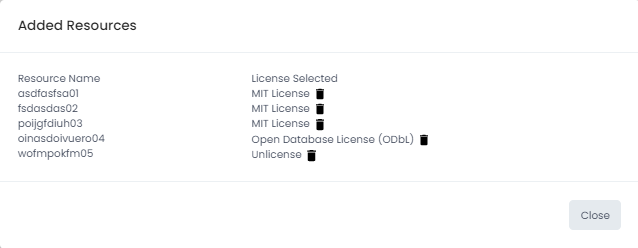
|
The Licensing out section provides information regarding the types of licenses under which the resource will be made available on the basis of the compatibility calculation. Compatible licenses are presented in categories according to types (software, data, audio, etc.). Users have to make a licensing out choice to move to the next section. Sections 4 and 5 gather further information regarding the legal bases under which the resource may be lawfully processed and provide a check-list of other types of rights that should be cleared before the resource is released to further assist resource managers in the clearance procedure. The last section provides a means to gather other notes and clarifications regarding rights and permissions related to the resource and enable future human interaction particularly concerning specialized legal advice. At this point users may hit "Submit" to trigger the creation of the output report, which may be downloaded once it has been generated by the platform. A sample report may be seen below:
A user profile page is available for logged in users, showing the information received by the NI4OS-Europe AAI service. Users have the ability to edit/add non-essential information in their profile page, which is information that is not associated with the AAI mechanism. Clearances history is also available for logged in users, providing a list with previous wizard runs along with the produced reports. Users may download previous reports or access the wizard with the previously saved data and make modifications.
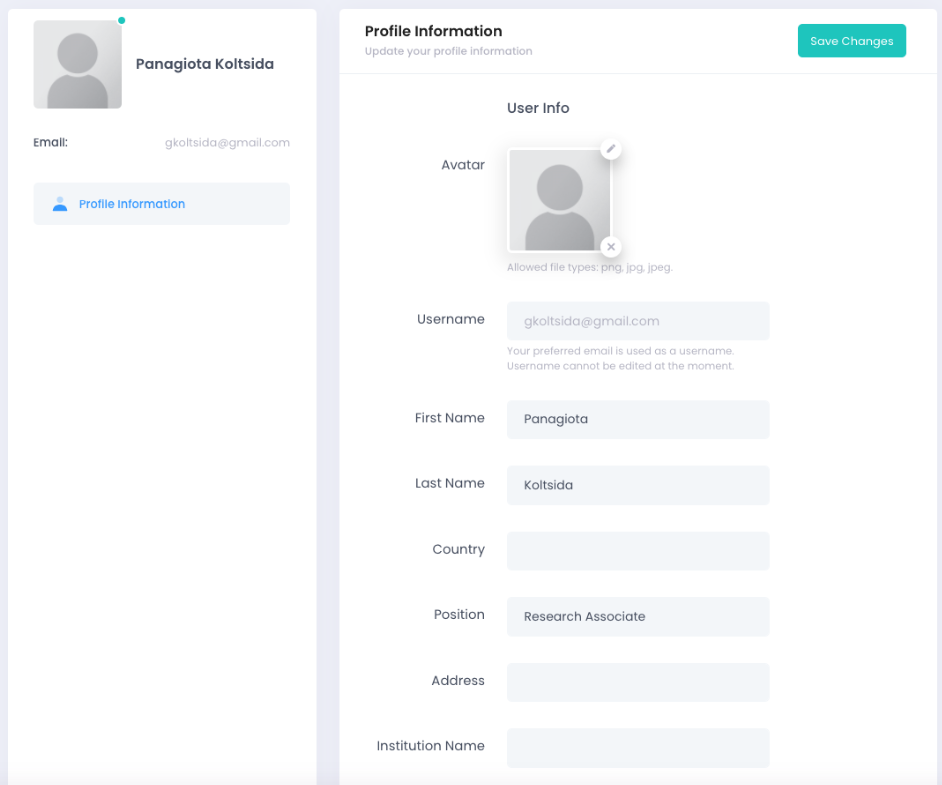 
|
Video Tutorial
Disclaimer
LCT and the produced reports do not constitute legal advice and should not be construed as such. If you need legal advice in relation to the release of your resources, please seek advice from a qualified lawyer in your jurisdiction. Athena Research Center and NI4OS-Europe project is not liable for any information, data or other input added to the application services by the users.
Version features
Version 1, June 2020:
- Initial version provides a proof-of-concept workflow.
- Will initially provide guidance for existing standard open-source licenses only.
- General Privacy policy is formulated
Release 1.0, September 2020:
- Name change to match the wider purpose of the tool.
- Production server reached at https://lct.ni4os.eu/
- Contact/issues form.
- Documentation, questions shortcut buttons.
- New branding logo.
- Updated Privacy Policy.
- Added terms of use.
- Reworked back-end compatibility algorithm.
- Reworked user interface.
- Added ability to input free text notes (Tab 6).
- Mandatory fields validation.
- Create e-mail service
Release 1.1, February 2021:
- Added AAI mechanism utilising NI4OS-Europe AAI
- Added registered users profile pages
- User profile page may be edited.
- Reporting history for each registered user is automatically saved.
- Older reports for registered users may be accessed, loaded and edited and produced reports may be re-downloaded.
- Cookies policy and consent has been added.
- Privacy policy has been updated.
Release 1.2, May 2021:
- Second workflow functionality added.
- User manual produced.
- Privacy policy has been updated.
- Terms of Use added.
- Renamed releases.
Release 1.3, July 2021:
- Admin pages added for privileged users.
- Tool description updated to reflect project review recommendations.
- Updated user manual and added easy access link within the application.
- Updated Privacy Policy.
- Updated terms of use.
Release 2.0, December 2021:
- Licenses’ attributes integration on all licenses
- Integration of license recommendation functionality in both workflows
- New page has been added in the app to provide information for each license
- Custom Cookie banner implementation to allow users to accept or decline the usage of analytics
- Integration with Google analytics
- Performance improvements. Faster loading of the form wizard
Team
Panagiota Koltsida, Marianna Katrakazi, Christos Liatas, George Panagiotopoulos, Panoraia Spiliopoulou, Theodore Stefou, Eleni Toli
